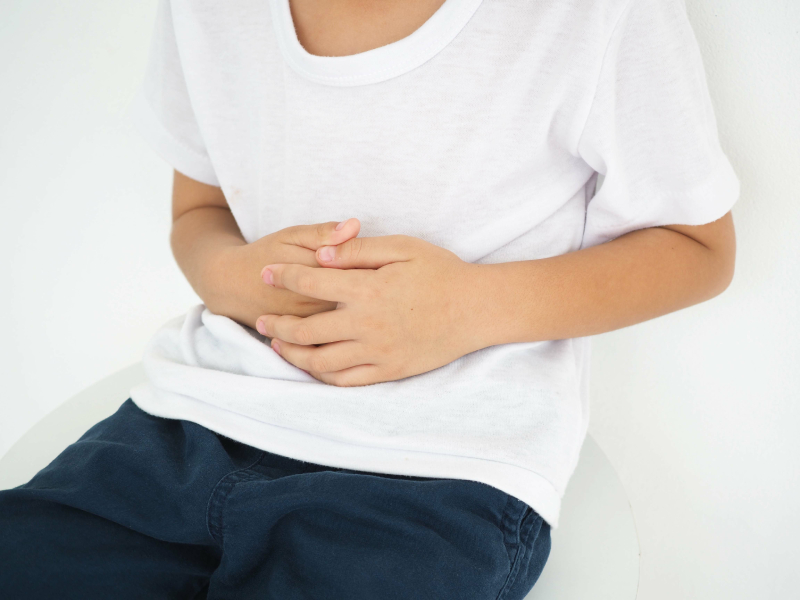Gastroesophageal Reflux Disease Causes in Children
Acid reflux in kids, also known as gastroesophageal reflux disease (GERD), occurs when stomach acid flows back up into the esophagus, affecting children and teens. GERD is often caused by factors that weaken the lower esophageal sphincter (LES), a muscle that opens to let food into the stomach but sometimes fails to close properly, allowing acid from the stomach to back up into the esophagus. This reflux means stomach acid goes back into the food pipe, leading to gastroesophageal reflux disease symptoms such as heartburn, an acid taste, and bad breath.
In infants and older children, GERD symptoms may include fussiness, frequent spit-ups, arching backwards, and refusing to eat. Gastroesophageal reflux disease causes in children can range from stress to specific dietary triggers. Reflux occurs more often when the production of stomach acid is excessive or if the child is burped and has an acid taste in the mouth. GERD in infants is common, as they naturally have a weaker LES. Children with reflux may experience asthma-like symptoms, respiratory issues, or coughing as acid reflux irritates the airways. Endoscopy, a procedure involving a flexible tube, may be used to diagnose GERD by examining the upper GI tract, including parts of the stomach and small intestine, to measure the amount of acid the stomach makes and to identify non-acid reflux. For older children, an upper GI series or gastric emptying study can help diagnose reflux and determine the severity of the condition.
Treatment will depend on the severity of symptoms and may include dietary changes, smaller portions at mealtimes, or specific medications to decrease the amount of acid produced in the stomach. If your child has reflux or is diagnosed with gastroesophageal reflux, consulting with a healthcare provider can help manage the condition and alleviate discomfort.
What are Childhood Reflux Symptoms
Heartburn is the most common symptom of GERD, and it can also present as a burning sensation in the chest or throat. This burning may lead to upper abdominal pain, particularly on the right side, and can last for up to 2 hours. The pain often becomes worse after eating, and lying down or bending over post-meal may increase the discomfort. Treatment for GERD may include medicines to reduce acid, such as proton pump inhibitors, which help reduce acid production.
Children younger than age 12 may experience different gastroesophageal reflux disease symptoms, such as a dry cough, asthma symptoms, or difficulty swallowing. They may not have classic heartburn.
Fortunately, GERD management can include nutrition-based lifestyle changes. From a dietary perspective, there are three primary categories of foods known to promote GERD symptoms.
- Some foods affect the muscle tone of the LES, allowing it to stay open longer. These foods include:
- Chocolate
- Peppermint
- High-fat foods (Meat, Dairy, Fried Foods)
- Some foods can bring on symptoms simply because they are acidic. These foods include:
- Citrus
- Tomatoes and tomato sauces
- Onions and Garlic
- Spices that increase stomach acid such as Peppermint, Fennel, Licorice
- Spicy Foods
- Coffee and Black Tea
- Some forms of GERD may result from gastrointestinal issues like poor digestion, constipation, and bloating. The pressure that builds up in the digestive tract can push the stomach contents upwards, leading to acid reflux and chest pain. Foods that are more difficult to break down such as raw cruciferous vegetables – like broccoli, cauliflower, cabbage, Brussels sprouts – can worsen esophagitis, especially in cases of poor digestion. While a diet rich in fruits and vegetables can reduce the risk of GERD in the long run, it is advisable to soften or cook raw vegetables before eating when reflux is active. Talk to a healthcare professional about medication and surgery options if chronic acid reflux persists.
H2: Managing GERD Treatment and Risk Factors
Not all reflux is caused by high stomach acid; the contents of the stomach are always acidic, but their acidity can range from weak to strong. Factors like stress, bacteria, certain medications, or diet can weaken stomach acid, potentially leading to gastroesophageal reflux (GER) and GERD-like symptoms. If you are diligently managing symptoms but don’t notice any improvement, consider consulting a naturopathic doctor who can help diagnose GERD and identify any additional natural supports or underlying issues contributing to your child’s occasional acid reflux. Therapeutic massage and reiki therapy are recognized for their ability to reduce stress, which can trigger gastroesophageal reflux disease, and deep tissue massages provided by a registered massage therapist may alleviate the physical tension that causes heartburn and other symptoms. Innate Wellness offers consultations for diagnosing gastroesophageal reflux disease (GERD) in children, understanding that symptoms can range from heartburn, chest pain, and shortness of breath to more severe conditions like esophageal stricture and esophagitis. Their approach includes lifestyle changes, dietary adjustments, and natural supports to reduce acid reflux and manage GERD effectively. If your child is experiencing symptoms of gastroesophageal reflux disease, contact Innate Wellness today for expert guidance and support with Acid Reflux in kids.
Some other things to consider and informative content about the gastroesophageal reflux disease can be found in these links:



